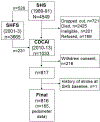Mid-Life Physical Activity and Late-Life Cognitive Performance among American Indians
- PMID: 35114678
- PMCID: PMC9121743
- DOI: 10.1159/000521791
Mid-Life Physical Activity and Late-Life Cognitive Performance among American Indians
Abstract
Introduction: Research on factors associated with late-life cognitive performance in diverse racial/ethnic groups is increasingly important due to the growing size and racial diversity of the elder population.
Methods: Using data on American Indians (AIs) from the Strong Heart Study, we measured associations between mid-life physical activity (PA), assessed by a questionnaire or pedometer, and performance on tests of general cognitive function, phonemic fluency, verbal learning and memory, and processing speed. Cognitive tests were administered 7-21 years after PA measurements. To estimate associations, we used regression models with and without inverse-probability weights to account for potential attrition bias in the cohort.
Results: Questionnaire and pedometer measures of PA were positively associated with cognitive function. Participants in the top quartile of questionnaire-based PA had Modified Mini-Mental State examination scores 3.2 (95% CI: 1.5-4.9) points higher than participants in the lowest quartile. Phonemic fluency scores also trended higher for participants in the top compared to the bottom categories for both PA measures: top questionnaire quartile = 2.7 (95% CI: 0.6-4.8) points higher and top pedometry tertile = 6.7 (95% CI: 2.7-10.7) points higher. We observed no associations between PA and tests assessing verbal learning and memory, or processing speed. Weighted model results were similar, but less precise.
Conclusions: In this cohort of AIs with relatively low levels of PA, positive associations between mid-life PA and late-life cognitive performance were dose-dependent and of modest clinical significance.
Keywords: American Indians; Attrition bias; Cognitive function; Pedometry; Physical activity.
© 2022 S. Karger AG, Basel.
Conflict of interest statement
Conflict of Interest Statement
CLC serves as a consultant to PATH and receives compensation from Adaptive Biotechnologies.
Figures

References
-
- National Association of Chronic Disease Directors. Subjective Cognitive Decline--A Public Health Issue In: Prevention CfDCa, editor. 2018.
-
- Vincent GK, Velkoff VA. The next four decades: The older population in the United States: 2010 to 2050 (No. 1138) In: Bureau UC, editor.: US Department of Commerce, Economics and Statistics Administration; 2010.
-
- Centers for Disease Control and Prevention. Diabetes prevalence among American Indians and Alaska Natives and the overall population--United States, 1994–2002. MMWR Morb Mortal Wkly Rep 2003. Aug 1;52(30):702–4. - PubMed
-
- Denny CH, Holtzman D, Cobb N. Surveillance for health behaviors of American Indians and Alaska Natives. Findings from the Behavioral Risk Factor Surveillance System, 1997–2000. MMWR Surveill Summ 2003. Aug 1;52(7):1–13. - PubMed
-
- Steele CB, Cardinez CJ, Richardson LC, Tom-Orme L, Shaw KM. Surveillance for health behaviors of American Indians and Alaska Natives-findings from the behavioral risk factor surveillance system, 2000–2006. Cancer 2008. Sep 1;113(5 Suppl):1131–41. - PubMed
Publication types
MeSH terms
Grants and funding
- P60 MD000507/MD/NIMHD NIH HHS/United States
- U01 HL041642/HL/NHLBI NIH HHS/United States
- P01 AG066584/AG/NIA NIH HHS/United States
- R01 AG071514/AG/NIA NIH HHS/United States
- R01 HL109315/HL/NHLBI NIH HHS/United States
- 75N92019D00028/HL/NHLBI NIH HHS/United States
- R01 HL109284/HL/NHLBI NIH HHS/United States
- U01 HL065521/HL/NHLBI NIH HHS/United States
- 75N92019D00027/HL/NHLBI NIH HHS/United States
- R01 HL109301/HL/NHLBI NIH HHS/United States
- U01 HL065520/HL/NHLBI NIH HHS/United States
- U01 HL041654/HL/NHLBI NIH HHS/United States
- U54 MD000507/MD/NIMHD NIH HHS/United States
- R01 HL093086/HL/NHLBI NIH HHS/United States
- U01 HL041652/HL/NHLBI NIH HHS/United States
- 75N92019D00029/HL/NHLBI NIH HHS/United States
- P50 AG005136/AG/NIA NIH HHS/United States
- 75N92019D00030/HL/NHLBI NIH HHS/United States
- K01 AG057821/AG/NIA NIH HHS/United States
- R01 HL109319/HL/NHLBI NIH HHS/United States
- P30 AG066509/AG/NIA NIH HHS/United States
- P30 AG059295/AG/NIA NIH HHS/United States
- R01 HL109282/HL/NHLBI NIH HHS/United States

